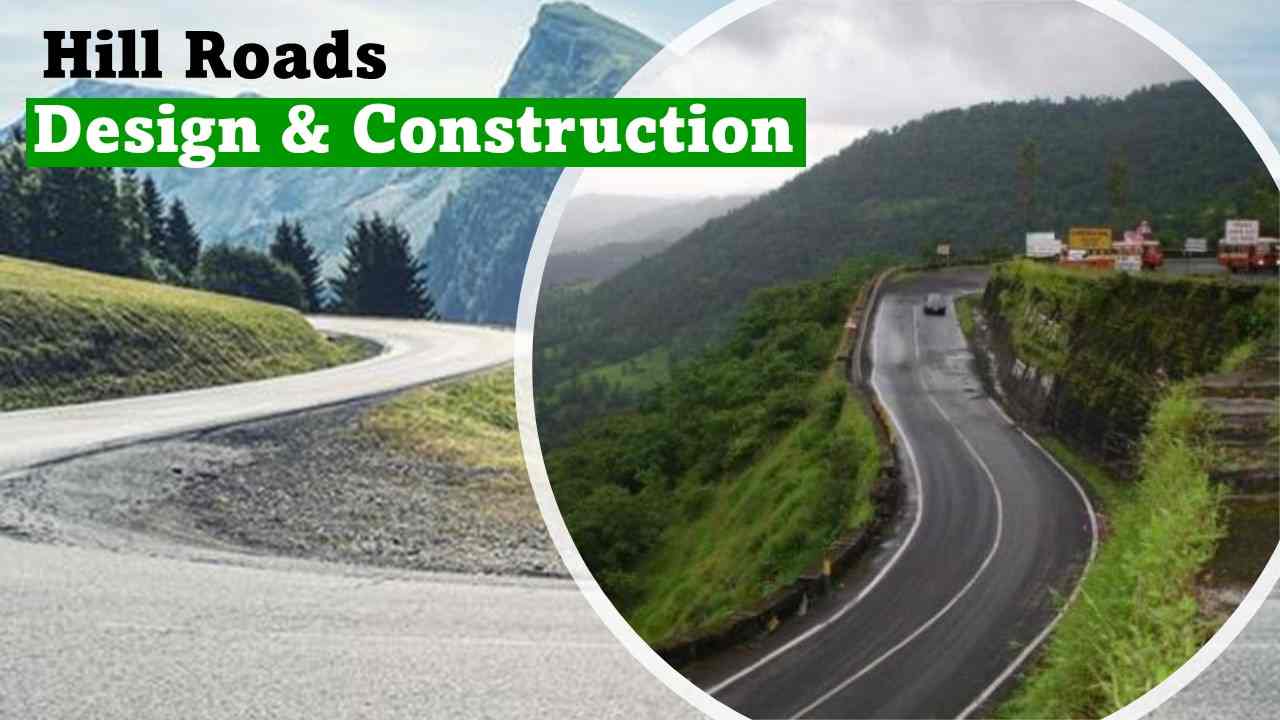Design and Construction of Hill Roads
- By
- Pooja |
- July 16, 2022 |
- Civil Engineering, Highway Engineering,

Table of Contents
Conventional Method of the Survey:
Typical Cross-sections – 2 lane carriageway (as per IRC:SP:73-2015)
Typical Cross-sections – 4 Lane Carriageway Widening Towards Valley Side (as per IRC:SP:84-2014)
Alignment in the vertical direction
What are Hill Roads?
Hill roads or Ghat roads are the names given to roads built in steep areas. The design, building, and upkeep of these roadways provide a significant challenge. Mountainous terrain has a cross slope of 25% to 60%, while high hilly terrain has a cross slope of 60% or more.
Alternatively stated:
The term hill road refers to a road that is built on a hillside with a transverse slope of more than 25%. Ghat Road and Hill Road are both alternate names for the same road. These highways' alignment design, planning, building, and maintenance are all more problematic. These roads are more expensive to build and more likely to be involved in a collision.
Hill roads are characterised primarily by width constraints, many hairpin bends and corner bends, sight distance restrictions and problematic surface drainage.
Importance of Hill Roads
In mountainous or hilly terrain, roads and trains may be the only options for transportation. The relative economics of the two options should be the deciding factor, and the following criteria clearly favour steep roads:
-
Economic growth can be accelerated by constructing a road of limited width, which will open up the local economic development region and allow for future enhancements in the roadway system.
-
There is no doubt that building railroads costs significantly more than building roads in steep regions.
-
It's possible to build roadways with steeper grades, which will shorten the length of roadways compared to the length of roadways required by rail traction for the same height.
The following functions of hill roads help illustrate their significance:
-
In terms of modern civilization, culture, and education, the mountainous regions lag behind, necessitating significant economic growth.
-
In these regions, farming is the primary source of income.
-
Among fruits, apples, apricots, cherries, etc., and among vegetables, potatoes, ginger, etc., the hills are wonderful.
-
In the absence of maize and other indigenous food grains, the economic well-being of the population can be significantly improved by growing and transporting these high-paying crops outside the country.
-
In the hills, there is a great deal of forest wealth.
-
Materials such as structural and nonstructural timbers, minerals, stones, and the like are essential for the development of both the country as a whole and the hilly regions in particular, but only if they can be transported to the plains, where they can be processed and shipped to consumers, in an efficient manner.
-
As far as industrial growth is concerned, some parts of the mountains are perfect for growing tea and jute and raising silkworms.
-
In hilly places, the presence of roads can aid in the establishment of enterprises producing these goods.
Alignment of Hill Roads
-
Hill roads must connect some mandatory locations due to administrative, developmental and strategic reasons.
-
Saddle passes, river crossings, and other naturally occurring characteristics, such as unstable places, would serve as control points for the route.
-
A few plausible alternative alignments can be found by focusing just on summit locations and descending from there. The alignment subsequently selected by joining the mandatory and control sites should satisfy the requirements of geometries vis-a-vis the needs of traffic, as also the terrain and climatic conditions.
-
The most cost-effective alignment will be the one that has the least impact on the environment and ecological balance while also yielding the lowest total transportation expenses. This includes costs for road building and maintenance as well as recurrent costs for vehicle operation.
-
Hair-pin bends should be kept to a minimum if at all practicable on the route. If judged unavoidable, their number should be the absolute minimum. The curves should also be situated on level, firm ground. Location of hairpin bends in valleys should be avoided. Also, steer clear of a sequence of tight turns on the same side of the slope.
Method of Preliminary Survey
It is possible to conduct a preliminary survey using any of the following methods.
Conventional Method of the Survey:
-
In the usual approach, surveys are performed by utilizing field equipment such as metallic tape, chain, prismatic compass, plane table, levelling device, theodolite etc.
-
The survey crew carries out the measurements, collate topographical and other important data and also perform soil survey.
Modern Method of the Survey:
-
In this procedure, essential topographic and other maps comprising data of soil and geographical aspects of the area are gathered through an Arial survey.
Geometric Design Standards
Hill Road design standards in India include the following:
-
The IRC:SP:48-1998 Hill Road Manual.
-
Alignment Survey and Geometric Design of Hill Roads, IRC:52-2001.
-
Tunnels under roads are governed under IRC:SP:91-2010.
Hill Road Capacity
Design Speed:
The design speed for several sorts of hill roads are provided below:
Sight Distance:
Safety on the road requires that drivers be able to see at all times. In order to avoid accidents, drivers must have enough time and space to stop their vehicles in the event of a collision.
Typical Cross-sections – 2 lane carriageway (as per IRC:SP:73-2015)
Typical Cross-sections – 4 Lane Carriageway Widening Towards Valley Side (as per IRC:SP:84-2014)
In tough terrain, reversible curves are a need. In order to introduce the necessary transition curves between the two curves, there must be enough distance between them.
Broken-back curves are curves that have tangents in the same direction but are separated by short tangents. In the interest of aesthetics and safety, they should be avoided as much as possible and replaced by a single curve. A minimum tangent length of 10 seconds must be maintained between the two curves if this is not possible.
It is conceivable to use compound curves in difficult topography, but only in cases when a single circular curve cannot be accommodated. Curves should not be disproportionally flat or steep in order to prevent injury and offer a comfortable ride for riders in the middle. The ratio of 1.5:1 should serve as a guideline.
Set Back Distance
To see the interior of horizontal curves, you'll need to be able to see at a sufficient distance. There may be obstructions in the lateral direction such as walls cut, hills and wooded areas, as well as high crops.
Vision Berm
An approximation of clearance height can be determined by looking at the average height of a sight line on the inside of a horizontal curve. When cutting back the slope to define the set back distance envelope, it is necessary to keep the cut slope below this height, which is also referred to as a vision berm.
Alignment in the vertical direction
Because of the increased risk of soil erosion along the road's bed, a milder vertical gradient is required for the road's vertical alignment.
Creating a vertical profile that is in harmony with the topography of the area results in less spoil since the cut-fill quantities are optimal and balanced.
Maintaining the finished road's level and fill slopes above the high flood level (HFL).
Preventing moist pavement layers by avoiding contact with the water table line
reduces the risk of landslides and rock falls by adjusting the cut height.
Ensure that properties can be accessed quickly and easily.
Ensure a more secure intersection layout.
Vertical Alignment
At grade changes, vertical curves are included to ensure a smooth transition. A Square parabola should be used for both the summit and valley curves of the curve.
Sight distance dictates how long vertical bends can be. Curves that are longer are more visually appealing. Hair-pin Bends may be created as a Circular Curve with Transitions or as a Compound Circular Curve in certain situations.
I hope the blog provides you with a sound understanding of Hill Road Design and its key design parameters.
Please feel free to like, share and comment.
Admin, gcelab.com
Please see our Pillar Post to know why we founded gcelab.com.
Read More:

Pooja
Founder at gcelab.com, Pooja is an Entrepreneur unlocking human potential. Working in the Principles of Lean Start-up, Pooja believes in Transparency and User Happiness the most. Pooja’s background in teaching gives her a sophisticated grasp on even the most tedious aspect of course building. She is passionate about people who believe that good is not enough.
Previous Post
What is Remote Sensing?
Next Post



